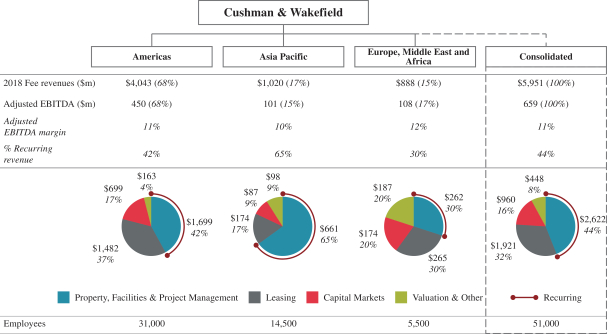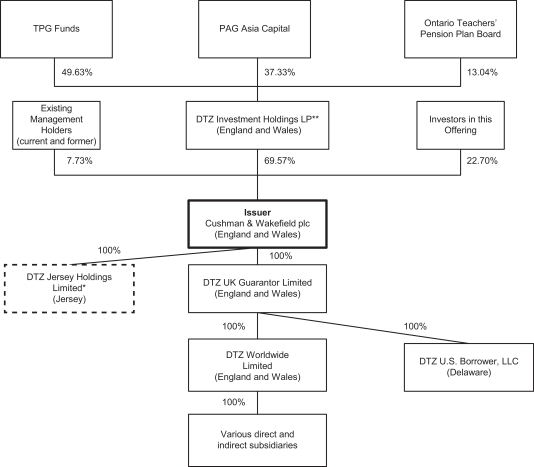DESCRIPTION OF CERTAIN INDEBTEDNESS
We summarize below the principal terms of the agreementscredit agreement that governgoverns our existing indebtedness. We refer you to the exhibitsexhibit to the registration statement of which this prospectus forms a part for copiesa copy of agreementsthe agreement governing the indebtedness described below.
First Lien Credit Agreement
The BorrowersOn August 21, 2018, certain of the Company’s subsidiaries, including DTZ U.S. Borrower, LLC (the “US Borrower”) and DTZ UK Guarantor Limited (the “UK Guarantor”) entered into a first lien credit agreement (the “2018 First Lien Credit Agreement”) with the lenders and issuing banks party thereto and JPMorgan Chase Bank, N.A., as administrative agent and collateral agent which provides for (i) a $2,700 million senior secured term facility (the “Term Loan Facility”) and (ii) a $810 million senior secured revolving credit facility (the “Revolving Credit Facility”), which may be used for revolving credit borrowings in dollars or certain other currencies described in the 2018 First Lien Credit Agreement, the issuance of one or more letters of credit from time to time (up to an aggregate of $220 million) and one or more swing line loans from time to time (up to an aggregate of $45 million). US Borrower is the sole borrower under the Term Loan Facility and the Revolving Credit Facility. On August 21, 2018, the Company borrowed $2,700 million under the Term Loan Facility (the “2018 First Lien Term Loan”). The 2018 First Lien Term Loan matures on August 21, 2025. The maturity date for the Revolving Credit Facility is August 21, 2023. The US Borrower, UK Guarantor and certain other subsidiaries of the Company also entered into security, guaranty and other agreements on August 21, 2018 in relation to the 2018 First Lien Credit Agreement.
The proceeds of the 2018 First Lien Term Loan were used to repay in full all outstanding indebtedness of the US Borrower and DTZ Aus Holdco Pty Limited (the “Australian Borrower”) under the First Lien Credit Agreement, dated as of November 4, 2014 in connection with the acquisition of DTZ, which was subsequently amended as of August 13, 2015, September 1, 2015, December 22, 2015, April 28, 2016, June 14, 2016, November 14, 2016, September 15, 2017(the “2014 Credit Facility”), and March 15, 2018. The First Lien Credit Agreement originally provided for termterminate all commitments in the aggregate amount of $750.0 millionthereunder, pay fees and Revolver commitments in the aggregate amount of $200.0 million (after giving effect to $280.0 million in term commitments and $50.0 million in Revolver commitments at a delayed draw date in connection with the acquisition of Cassidy Turley on December 31, 2014).
As of March 31, 2018, the First Lien Credit Agreement has been amended several times since establishment of the loan which has resulted in additional borrowings of $2.0 billion and an outstanding principal balance of $2.6 billion.
The amendment as of August 13, 2015, or First Lien Amendment No. 1, provided for certain technical amendments to the financial reporting covenant.
The amendment as of September 1, 2015, or First Lien Amendment No. 2, provided for, among other things, incremental term commitments in the aggregate amount of $1.1 billionexpenses incurred in connection with the acquisitionabove and the 2018 First Lien Credit Agreement. In connection with the repayment of C&W Group,the outstanding borrowings under the 2014 Credit Facility, all guarantees of obligations under such facility were terminated, all security interests securing obligations under the facility were released and the 2014 Credit Facility was terminated.
Borrowings under the Term Loan Facility bear interest, at the US Borrower’s option, at a rate equal to either (i) the Eurodollar Rate (as defined in the Credit Agreement), plus an increaseapplicable margin equal to 3.25% per annum or (ii) the Base Rate (as defined in the Credit Agreement), plus an applicable margin equal to 2.25% per annum. The US Borrower selected an initial interest rate equal to the Revolver commitments inEurodollar Rate plus the aggregate amountapplicable margin of $175.0 million, the refinancing of existing term loans and the amendment3.25% per annum. The effective interest rate of the financial covenant under the Revolver.
The amendment2018 First Lien Loan was 6.0% as of December 22, 2015,31, 2018.
Borrowings under the Revolving Credit Facility bear interest at rates varying from 2.75% to 2.00% plus the Eurodollar Rate or 1.75% to 1.00% plus the Base Rate, based on achievement of certain First Lien Amendment No. 3, provided for incremental term commitmentsNet Leverage Ratios (as defined in the aggregate amountCredit Agreement). In addition, the US Borrower is required to pay a commitment fee of $75.0 million.
0.375% per annum for unused commitments under the Revolving Credit Facility, with a step down to 0.250% per annum upon achievement of a First Lien Net Leverage Ratio of 2.50:1.00 or less. The amendmentRevolving Credit Facility matures on August 21, 2023. The Company did not draw on the Revolver at any point during 2018 and had no outstanding borrowings thereunder as of April 28, 2016, or First Lien Amendment No. 4, amendedDecember 31, 2018.
All of the US Borrower’s and Guarantors’ (as defined below) obligations under the 2018 First Lien Credit Agreement to, among other things, effectare guaranteed by the UK Guarantor, certain technical amendments tosubsidiaries of the financial reporting covenant.
The amendment asUK Guarantor incorporated in England and Wales and certain material US subsidiaries of June 14, 2016, or First Lien Amendment No. 5, provided for incremental term commitments in the aggregate amountUK Guarantor (such entities, collectively, the “Guarantors”). All of $350.0 million.
The amendment as of November 14, 2016, or First Lien Amendment No. 6, provided for incremental term commitments in the aggregate amount of $215.0 million. The new cash proceeds from the incremental term commitments under First Lien Amendment No. 6 were used to refinanceUS Borrower’s and prepay the outstanding principal of $210.0 millionGuarantors’ obligations under the Second Lien Loan and $5.0 million of the $25.0 million incremental term loan principal under the Second Lien Credit Agreement.
The amendment as of November 14, 2016, or First Lien Amendment No. 7, amended the financial covenant under the Revolver.
The amendment as of September 15, 2017, or First Lien Amendment No. 8, extended the maturity of approximately $296.2 million of the $375.0 million of outstanding Revolver commitments to the earlier of September 15, 2022 and any date that is 91 days before the maturity date with respect to any First Lien term loans.




 ” names. Although we believe
” names. Although we believe ” names. We primarily operate under the “Cushman & Wakefield” name and have generally adopted a strategy of having our acquisitions transition to the “Cushman & Wakefield” name. We own numerous domain names and have registered numerous trademarks and/or service marks globally. With respect to the Cushman & Wakefield name, we have processed and continuously maintain trademark registration for this trade name in most jurisdictions where we conduct business. We obtained our most recent U.S. trademark registrations for the Cushman & Wakefield name and logo in 2017, and these registrations would expire in 2027 if we failed to renew them.
” names. We primarily operate under the “Cushman & Wakefield” name and have generally adopted a strategy of having our acquisitions transition to the “Cushman & Wakefield” name. We own numerous domain names and have registered numerous trademarks and/or service marks globally. With respect to the Cushman & Wakefield name, we have processed and continuously maintain trademark registration for this trade name in most jurisdictions where we conduct business. We obtained our most recent U.S. trademark registrations for the Cushman & Wakefield name and logo in 2017, and these registrations would expire in 2027 if we failed to renew them. ”) names. We primarily operate under the “Cushman & Wakefield” name and have generally adopted a strategy of having our acquisitions transition to the “Cushman & Wakefield” name. We own numerous domain names and have registered numerous trademarks and/or service marks globally. With respect to the Cushman & Wakefield name, we have processed and continuously maintain trademark registration for this trade name in most jurisdictions where we conduct business. We obtained our most recent U.S. trademark registrations for the Cushman & Wakefield name and logo in 2017, and these registrations would expire in 2027 if we failed to renew them.
”) names. We primarily operate under the “Cushman & Wakefield” name and have generally adopted a strategy of having our acquisitions transition to the “Cushman & Wakefield” name. We own numerous domain names and have registered numerous trademarks and/or service marks globally. With respect to the Cushman & Wakefield name, we have processed and continuously maintain trademark registration for this trade name in most jurisdictions where we conduct business. We obtained our most recent U.S. trademark registrations for the Cushman & Wakefield name and logo in 2017, and these registrations would expire in 2027 if we failed to renew them.